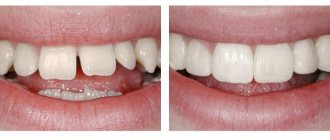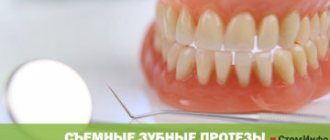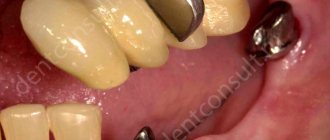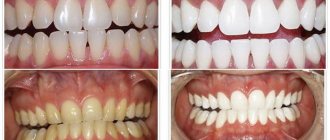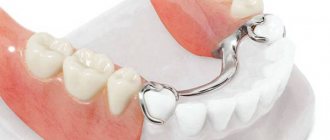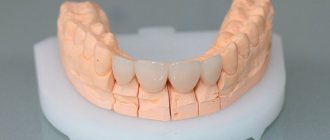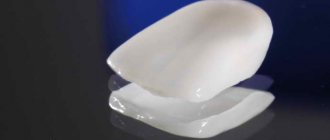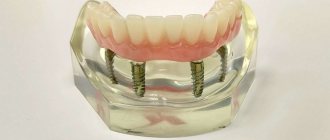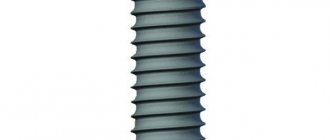To correct defects in the appearance and chewing function of teeth, a variety of prostheses are used: crowns, bridges, implants, veneers. In many cases, it is better to install veneers. They, like crowns, can be made of different materials and are secured in various ways. But the size of these microprostheses is smaller, and they cover only the front surface of the tooth.
Indications for installation of veneers
Dental veneers are microprostheses that, when installed correctly, look like natural teeth. They are used if the appearance and shape of the dentition cannot be corrected by other methods; most often, teeth up to the fifth from the top and to the fourth from the bottom are restored this way .
Photo: this is what teeth look like before and after installation of veneers
The process of creating overlays and installing them is very short, and even for the highest quality models does not exceed 1 week.
Veneers last a long time: according to statistics, after 16 years of wear, microprostheses remain intact in more than 70% of patients.
Indications for prosthetics with veneers are:
- Excessive yellowing of the enamel, including “tetracycline teeth” that have turned yellow due to the side effects of antibiotics taken.
- Enamel with signs of fluorosis.
- Unaesthetic appearance of enamel after pulp removal.
- Incorrect anatomical shape or incorrect position of the tooth: rotation around an axis, enlarged interdental spaces or crowding.
- Fillings on the visible part of the dentition, which differ in color from the natural shade.
- Improving the aesthetics of the dentition, in other words, creating a “Hollywood smile.”
- Correction of defects that are not amenable to other restoration methods.
- Chips of tooth parts.
Photos before and after straightening the edge of a tooth with a veneer
When asked what age is the best time to get veneers, most dentists will give the same answer: at any age after adulthood. Microprostheses are not placed on baby teeth , and after 18 years of age, natural alignment and formation of the bite occurs.
Basic information about veneers
The installation procedure for such a coating is simple. At the first stage, the natural tooth enamel is polished. A very small layer of tissue is removed, which does not exceed a thickness of 0.3 mm. Thanks to this, the procedure is minimally invasive and does not spoil the overall condition of the teeth. Such manipulations make it possible to ensure a tighter fit of the veneer to the enamel surface. This prevents food and other substances from getting in there that could contribute to destruction.
The main materials used to make veneers are ceramics and polymers. Ceramic options are characterized by increased strength and durability. They will serve for more than 20 years without losing their quality and aesthetic characteristics. Their cost is quite high. However, after installation, you can be sure that no additional restoration work will be required throughout the entire service life.
Composite types, that is, made from polymers, will be cheaper. Such materials are used for refurbishment. Although not as expensive as the previous option, they are inferior in quality. This type will not be durable, nor is it very strong. After a certain period of time, coatings may lose their appearance, resulting in the need for replacement.
Which prosthetic method to choose
If a person has severe dental defects, the dentist may offer him restoration, installation of braces, crowns or veneers. Each method has its own characteristics:
- To ensure a tight fit of the artificial crown, the teeth are ground down on all sides and very deeply. But crown dentures can correct a defect on any side of the tooth surface.
- When installing a veneer, only the thinnest layer of enamel is ground off, no more than 1 mm.
- If you need to straighten your teeth, a more effective way would be to install braces, especially since this method does not require much grinding of the tooth surface.
- When straightening lower or upper teeth with braces, the system is noticeable on the teeth; old-type metal braces look especially unaesthetic.
- Veneers, when installed correctly, completely blend with the teeth.
- Restoring teeth with light-polymer filling materials does not ensure the achievement of the natural translucency of the tooth, so the filled area may differ greatly from the surrounding dental tissue.
- Correction with veneers ensures a translucent surface, especially with ceramic ones, since the appearance of composite products changes over time.
- The materials used for veneering rarely cause allergies , which sometimes develop with other dental procedures.
Despite the fact that such properties of dental veneers often seem optimal, microprostheses also have disadvantages. There are situations when you shouldn't install them.
How to properly carry out hygiene procedures with veneers?
The advantage of using a method such as veneering is the ease of further oral care. After the procedure, you can continue to eat your usual food and drinks. It is enough to brush your teeth twice a day using any toothpaste. It would be useful to additionally use a special thread that will ensure healthy gums.
To maintain an aesthetically pleasing appearance, it is recommended to have your mouth professionally cleaned twice a year. However, this is not advice only for those who wear structures. This procedure will be useful to everyone.
Using veneers on crooked teeth or simply to improve the aesthetics of a smile solves many additional problems. Thanks to the presence of thickened enamel, it is possible to permanently get rid of increased sensitivity. The maximum tight fit during installation allows you to avoid further occurrence of caries or other dental diseases. Additional self-confidence appears, because a person with a snow-white smile calmly communicates with others and is not shy to smile and laugh. This can become a very effective business card for anyone.
Calculator: calculate prices online
Calculation of the cost of turnkey veneers
Calculate the cost of installing veneers yourself.
For an accurate final calculation, the cost of fixation is added to each veneer - 500 rubles. and once for the entire work, the cost of casts is 1200 rubles.
Choose the type of veneers
0
Please indicate the required number of veneers
Better and more accurate - in a free consultation! All addresses and telephone numbers are on the website chudostom.ru. Make an appointment by calling the branch closest to you.
The calculation is not a public offer; the final cost is determined at a free consultation BEFORE the start and does not change during the treatment process.
Total cost rub.
0
Contraindications and disadvantages of veneering
Having learned about dental veneers, many people seek to make such prostheses for themselves in order to forget about dental defects. But veneering is not suitable for everyone; there are also contraindications for it:
- Intensive abrasion of dental tissues.
- Predisposition to bruxism - night grinding of teeth.
- Malocclusion.
- Damage to the teeth on the inside or the presence of a large filling on the tongue side.
- Missing many teeth.
- It is not advisable to put any type of veneers on the teeth of a person who has bad habits that lead to damage to dentures: the habit of biting nails or opening bottles with teeth.
- Veneering is not carried out for athletes with frequent cases of dental damage, for example, boxers.
The main disadvantage that is important for many patients is the high cost of the procedure . When trying to choose a less expensive type of prosthesis, you have to “sacrifice” quality. Another disadvantage is that the strength of these linings is quite high, but cannot provide absolute reliability.
An important nuance is the irreversibility of the procedure: if the appearance of the veneer is not satisfactory, or it is damaged, it cannot be removed, and a crown has to be installed.
Types of veneers: which ones are better?
For the manufacture of such microprostheses, various materials are used, which in color are practically indistinguishable from the patient’s natural teeth. The shade is selected individually in each case.
Modern dentistry offers:
- Ceramic veneers made from medical porcelain or zirconium dioxide. These microprostheses, up to 0.5 mm thick, are recognized as the best in strength and service life. They look like real teeth and do not lose their properties for a long time.
- Porcelain lumineers are the thinnest (about 0.2 mm) porcelain plastics that are installed even without grinding teeth or on artificial crowns. Microprostheses of this type are used to achieve the ideal “Hollywood smile” effect.
- Composite veneers are prostheses made from composite materials that are predisposed to interact with certain components of food and drinks. In terms of properties, they are incomparable to ceramic veneering, since they are short-lived and lose their aesthetic appearance over time. But their installation is simpler, often performed directly in the dentist’s office, rather than in a dental laboratory. Essentially, this type of veneer is a filling that masks the front surface of the tooth.
The choice of type of dental veneers largely depends on the financial capabilities of the patient. If a person is willing to pay a sufficient amount for prosthetics, preference is given to ceramic veneers, less often to porcelain lumineers, their cost is the highest. A budget option is veneering with composite dentures.
Service life of dental veneers
Often, patients with problematic front teeth have a choice between installing veneers and crowns. On the one hand, you want to preserve the vitality of the pulp and cut down as little tissue as possible. On the other hand, you don’t want to remove the onlays and install crowns after a year or two. Let's try to figure out what determines the service life of veneers, in which cases they should be installed and in which they should not be installed.
The duration of wearing the pads is very individual. It depends on:
- material for manufacturing a microprosthesis;
- bite ;
- compliance with all technical conditions and parameters in the laboratory;
- compliance with the rules of tooth treatment and fixation by a doctor;
- thorough oral care and compliance with scheduled visits to the doctor;
- presence of bad habits in the patient.
Of course, Emax veneers are considered the most durable and reliable today, their service life reaches 10-15 years . Zirconium veneers have a similar service life due to the dense frame. Overlays made from ordinary ceramic mass last at least 5 years . At the same time, the service life of composite veneers is the shortest. As a rule, the unit price directly corresponds to the service life of the future structure.
Preparation for prosthetics
The first stage is a visit to the dentist to examine the oral cavity, identify defects, contraindications and direct indications for installing a prosthesis. If there are no obstacles to prosthetics, the doctor, together with the patient, selects the material for making veneers and the shade, which should match the color of the teeth.
Before installing microprostheses, it is sometimes necessary to grind down the teeth for tighter contact between the surface of the crown and the veneer plate. But when using lumineers, this procedure is optional.
Silicone dental veneers, pros and cons
Veneers installed on silicone are artificial teeth that have high aesthetics and functionality. If you have many contraindications for installing onlays, and your smile wants the best, then silicone structures are exactly what you need.
- Identical to the oral mucosa.
- Very flexible, easy to work with.
- Does not create any inconvenience during operation.
- Ideally follows the shape of the palate and attaches perfectly to the gum.
- Quite a long period of operation up to 5 years.
- Creates difficulties while chewing solid food.
- Possible speech defects during adaptation.
Creation and installation of ceramic veneers
There are two methods of ceramic prosthetics:
- The dentist lays out the ceramic mass in layers and then fires it, resulting in unpressed ceramics.
- The specialist performs casting of the mass at high thermal and pressure indicators (pressed ceramics), this ensures much greater strength and service life of the lining.
Zirconium linings are turned on special milling machines; this process is automatic.
The stages of installation of ceramic microprostheses made in a dental laboratory are as follows:
- Making a three-dimensional impression.
- Computer modelling.
- How many days it takes from preparing the tooth to installing a permanent onlay depends on the particular nuances, the chosen material, and the complexity of the prosthetics. Therefore, plastic temporary microprostheses are placed on the patient’s ground teeth so that there is no discomfort in the oral cavity.
- Ready-made veneers are attached to pastes that come in different shades. At this time, the patient and dentist finally decide on the shade of the microprosthesis, since it greatly depends on the type of cement chosen. It will no longer be possible to correct the shade after this stage.
- The dentist installs an onlay on the permanent microprosthesis, after which it can no longer be adjusted.
- The patient must check whether the lower and upper teeth fit correctly with the veneers installed on them, and whether the correct bite has formed.
Photos before and after installing veneers on the lower teeth
How to place veneers
Before installing veneers, the doctor must thoroughly review your outpatient record and conduct a thorough examination of the oral cavity. In some cases, you may need to undergo a gum treatment procedure before proceeding with the placement and fabrication of the veneer.
The choice of material for plates is approached with full responsibility; this process can affect the subsequent ones - their manufacture, installation and price. There are two types of veneer plates - composite therapeutic and porcelain orthopedic.
After the examination, the doctor selects the necessary installation technique and the manufacturing process. If gum problems are identified, it will take some time to treat them. When selecting the material, the shade of the color of the veneer is discussed, and in order to avoid problems with the bite and the plate, each tooth undergoes separate preparation.
Before installing a veneer, teeth need to be cleaned; this occurs by removing a layer of enamel and the hard part of the tooth from 0.5 to 0.7 mm. The thickness of the removal directly depends on the thickness of the plate being installed, and it will be the smallest when making veneers from lumineers and composites. The cleaning procedure is not carried out completely , and during the manufacture of the veneer, a temporary plastic plate is placed for a period of 10 to 15 days. The procedure itself consists of the following steps:
- First, an impression is made from a special solution, it is applied to the tooth and wait until it hardens completely. The solution sets for 5 minutes, then the form is removed and taken to the laboratory.
- Then, based on the impression taken, a plaster impression with composite onlays is made.
- The finished plate is checked for consistency of shape and color. If there is no fit or any discomfort is felt, it is removed and moved until it fits 100% and does not interfere with eating or smiling.
- After the fitting procedure, the oral cavity and plate are treated to prevent the entry of microorganisms.
- The inside of the veneer is left rough, and the tooth is treated with a gel to give it a better roughness for good adhesion to the veneer.
- Cement paste is used for bonding, which quickly hardens when exposed to direct light.
- And at the last stage, all remaining cement is removed and the bite is checked.
Creation and installation of composite veneers
The properties of composite veneers depend on how they are made:
- Therapeutic composite onlays are made by dentists themselves in their office. They first grind down the front of the tooth, and then apply layer-by-layer composite reflective material.
Photo: therapeutic veneer on a front tooth
- The second method: the dentist grinds down the tooth, makes an impression of the veneer, from which an impression is created in the dental laboratory to model it. These are higher quality and more expensive composite microprostheses.
Photo: composite onlays (veneers) on teeth
Actions after installation
After installing veneers, the doctor should tell the patient what special care features there are. about two weeks, you should visit your dentist for a control check of the microprosthesis itself and the condition of the tissues surrounding it.
Some patients note that after correcting their appearance, their teeth become more sensitive. Despite this, they should be cleaned regularly, as recommended by standard hygiene practices. But you can’t put a lot of pressure on teeth with veneers to prevent them from deteriorating.
Particular care should be taken with prosthetic incisors that are used to bite off pieces of food. Especially with installed composite microprostheses, which are less durable. If a veneer has deteriorated, your dentist may suggest putting a crown on it. The same decision is made if the tooth under the veneer begins to decay.
If you want to install veneers, you should contact a good clinic that employs qualified dentists and uses high-quality materials. An experienced dentist will advise which method of correcting the dentition is most suitable for the patient.
Veneers Lumineers what are the pros and cons
One of the thinnest plates that do not require filing of the dental plate. They can be removed at any time, because the enamel underneath does not deteriorate at all. They can be used for up to 20 years. They are much thinner and are glued to the surface of the tooth using a special stable adhesive.
There are two types of such records:
- Made according to an individual impression.
- Pre-fabricated to standards. They come in sets in special boxes. The doctor selects them, the technology is the same as with nails.
- The onlays are attached without cutting down healthy enamel.
- Fast installation times.
- Does not require local anesthesia.
- Does not require preliminary installation of temporary overlays.
- They are not affected by food dyes, tea, coffee drinks, or nicotine.
- Do not cause harm to health.
- They have medical indicators and prevent the occurrence of caries.
- Not everyone can afford such luxury. The procedure is quite expensive.
- After attaching the onlay, the dental plate visually becomes thicker. This happens due to the fact that the surface of the tooth is not ground down. If the teeth are initially small, the thickening is unnoticeable.
